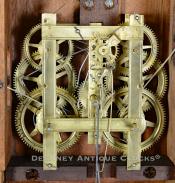J.J. Beals & Co. Clock Establishment. A true "Triple Decker." JJ-123.
This is a wonderful clock in fine original condition. It features the overpasted label of the Retailer J. J. Beals & Company's Clock establishment located at the sign of the large dials. The building was at the junction of Blackstone and Union Streets in Haymarket Square, Boston, opposite the new Boston & Maine Railroad Depot.
This colorful example stands approximately 33.25 inches tall, 16 inches wide, and 5.25 inches deep. It sits flat on the mantel, never having feet. The case is veneered in mahogany and retains its first surface. The case is divided into three distinct sections. All three are fitted with glass panels. The lower two panels are decorated with reverse designs. These floral-themed tablets are in good original condition and were painted by William Fenn. The upper door opens to access the wooden dial. The case sides are fitted with columns. The middle columns are fully turned and finished in gilding. The other four columns are split in half and applied to the case. These are finished in a smoke decoration. The caps are gilded. At the top of the case is a gallery. The clock world describes this as a splat supported by plinths capped at the top. A basket of fruit decorates the splat. This is formed with gesso and finished in gilt.
The wooden dial is painted, and the spandrel areas are decorated with floral themes. The time ring features Roman-style hour numerals on a dotted minute ring. Steel-shaped hands depict the time. The center of the dial is open so that one can see movement visually.
This is an early Connecticut brass movement. A series of riveted brass straps support the steel arbors and brass gearing. The design is a fascinating study of American ingenuity. The works are powered by weights that travel inside the length of the case. It will run eight times before winding is required. It is a time-and-strike design, striking via a countwheel on a wire gong mounted inside the case.
Open the lower door, and you will have access to the brass pendulum bob and rating nut. The Reatiler's label is pasted on the backboard. It has suffered some losses, but the graphics are very interesting. The facade of Beals's establishment is depicted. One should notice the advertising and the clocks mounted on the building. There are also clocks in the windows. On the street in front are push carts with clocks on board.
This is an excellent example. Clocks like this one were intended to sit on a wall shelf or mantel, but we have also seen them displayed on top of furniture.
This super clock was made circa 1845.
Inventory number JJ-123.














